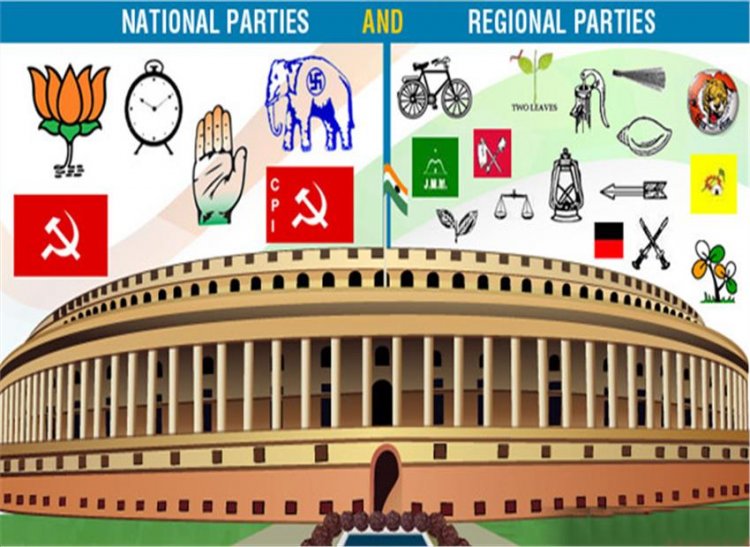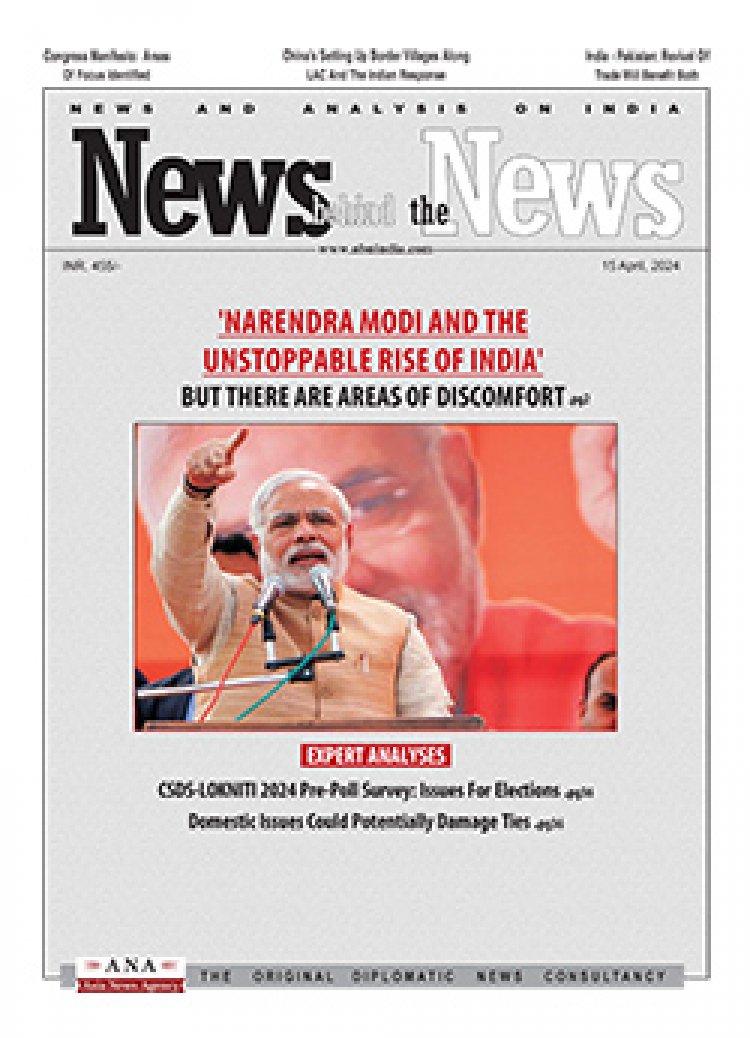Regional Parties: Obvious Limitations
Asia News Agency

Regional parties, in particular from South India, are wasting little time in putting up a challenge of sorts to the BJP before the 2024 elections. Barring Karnataka and Puducherry, the BJP has not got a footprint in the other four states.
Telangana and Tamil Nadu woo AAP
Tamil Nadu Chief Minister and DMK president, MK Stalin registered his presence in Delhi in early April, last week. Thereafter, Telangana Chief Minister K Chandrashekar Rao and the Telangana Rashtra Samithi (TRS) chief were in the capital, meeting Delhi Arvind Kejriwal.
The Aam Aadmi Party (AAP), which has governments in Delhi and Punjab, is an apparent challenger to the BJP after the Congress faded away in the north and parties like the Samajwadi Party and the Shiromani Akali Dal were routed in the February-March 2022 elections. Naturally, writes Radhika Ramaseshan (Senior journalist, The Tribune) “the southern leaders, ambitious to take their agenda and plans countrywide, have only the AAP to cling to, in realising their larger goal of unseating the BJP through a federal grouping.”
In an apparent rebuff to the Congress, Rao has made it clear that the Opposition’s endeavour to put up a joint candidate against the BJP/NDA in electing the next President this year had no place for the Congress. Unfortunately, Tamil Nadu CM Stalin will not be on board because he has a long-standing alliance with the Congress.
So, at a time when Odisha’s Chief Minister and Andhra Pradesh YSR (Chief Minister Yeduguri Sandinti Rajasekhara Reddy, popularly known as YSR) are willing to negotiate with the BJP every time there’s a legislative crunch in Parliament in return for favours done to their states, “the Opposition has to scout for another raison d’etre to justify its existence”.
Crux of a regional coalition
In the final analyses, “the crux of a regional coalition is this: be it the TMC, TRS, Shiv Sena, the DMK or the AAP, these forces have to protect their own turf from being poached upon by the BJP which is looking to make new conquests. The BJP may be considerably weakened in West Bengal, but it remains Mamata Banerjee’s principal adversary. So too in Maharashtra! Kejriwal, the south’s northern light, is up against problems in Punjab. He has to mind Delhi, so whether he has the time to sally forth into Himachal Pradesh is the big question. The limitations are obvious."
Congress in shambles
Congress meanwhile, is in shambles. For the third time this month, the party has suffered a jolt in the form of the departure of a senior leader. Former minister Kapil Sibal announced Wednesday that he has resigned from the party and filed his nomination as an independent candidate for the Rajya Sabha (RS), with support from the Samajwadi Party (SP). His exit, arguably the most high-profile in the party in two years, writes the Hindustan Times “comes at a critical time for the Congress, which is trying to rejuvenate its ranks after a clutch of demoralising losses. Sibal snapped his three-decade-old ties with the Congress after nearly two years of stormy exchanges as the de facto head of the G23 group of leaders pushing for internal reforms and elections. He was the rare Congress leader who publicly questioned the party’s leadership and first family, the Gandhis. His exit will strike a blow to the morale of the so-called G-23, which has only managed to make modest headway in its exchanges with the party’s leadership.”
Earlier, the Congress lost a capable senior figure like Sunil Jakhar in Punjab and the young, energetic Hardik Patel in Gujarat “through inefficiency and inept calculations at the central leadership level,” according to political observer Anand K. Sahay.
The resignations puncture the narrative of the Udaipur brainstorming session, that the party is seeking to rejuvenate. However, Rahul Gandhi’s forceful intervention was widely noted. He did not mince words when he said the Congress had lost its connect with the masses. He also chose to note that the Congress, alone among the Opposition parties, had an ideology that could challenge the BJP nationally.
Regional parties do not have a clear ideology
In knee-jerk reactions, writes Sahay, “some regional parties seen as ‘secular’ felt slighted. They spoke out, flaunting their local strengths to make their point. They appear to have missed the point wholesale. Plainly, they were being narrow-focused and pointlessly assertive, possibly adopting a pre-emptive posture for future seat negotiations with the Congress…..”
The plain fact is that “BJP’s regional opponents are chauvinistic and in some cases caste-centric, ducking behind slogans of development and discrimination even after gaining electoral and political salience. Politically they are ‘secular’ in that they do not practise discrimination against religious minorities (only against rival castes). Even so, it is true that they do not have a clear ideology.”
At another level, writes Sahay, “it’s hard to think India can grow in conditions of peace and stability on a long-term basis if sections of the population are sought to be alienated through coercive policy and pronouncements, or on the basis of an appeal to particular sections. Any attempt to do so will be a negation of the principle on which Independence was gained, and the post-colonial republic founded. And yet, besides the Congress, other parties appear to be distracted by expedient, seductive, slogans….”
Returning to the Congress, “its organisational structure seems to have evaporated. The apex relies on narrow-based selections and is not re-energised through intra-party competition. No ideology can be practised in any meaningful sense in the absence of a cohesive organisation. Rahul Gandhi can hardly evade responsibility on this count, though to be fair the decline and fall began long before him.”
Rahul Gandhi’s Understanding Of The Political Landscape: Three Discernible Themes
Former Congress president, Rahul Gandhi, was two weeks ago, in London to participate in a conference on contemporary India. “Since the Indian visitors to the event were exclusively drawn from one side of the political spectrum, it would not be unfair to see it as an attempt to create awareness in the West of the apparent misdeeds of the Narendra Modi government,” writes Swapan Dasgupta (journalist and politician, influential within the Indian right wing; nominated member of the Rajya Sabha the upper house of the Parliament).
Rahul Gandhi’s hour-long deliberation in the conference revealed a great deal of his political understanding and approach. Dasgupta identifies three discernible themes in the Congress leader’s understanding of the political landscape.
First, Indian democracy has become totally dysfunctional
“First, Gandhi proceeded on the belief that under Modi, Indian democracy has become totally dysfunctional. He believes that the environment for normal politics no longer exists. According to him, crucial institutions that are indispensable to democratic politics, notably the judiciary, the Election Commission and the bureaucracy, have lost their independence and are captive to the political interests of the Modi government…..
Second, economy is in a tailspin
“Secondly, Gandhi believed that the Indian economy is in a tailspin owing to the government’s dependence on a model of growth that had run out of steam in the last years of Manmohan Singh’s government. It is his belief that mass discontent is widespread, that the government has sprinkled kerosene all over the country, and a tiny spark would lead to India becoming engulfed in flames.”
In suggesting that India had been deeply polarised, Dasgupta says “he appeared to believe that the people are under the spell of what Marxists used to call ‘false consciousness’. It needs the Congress and its supporting parties to show them the light and the ground would be ready for change…..
Thirdly, India’s political identity lay in it being a ‘union of states’
Thirdly, and surprisingly, “Gandhi stressed that India’s political identity lay in it being a ‘union of states’ — and not a nation. Consequently, he stressed the paramount importance of divergent identities and the need to negotiate a rainbow coalition after prolonged conversations with disparate stakeholders.”
If it was Gandhi’s intention to project himself as markedly different from Modi, Dasgupta writes “he appears to have succeeded. But he left unanswered the larger question of whether this agonised, quasi-Woke approach will inspire voters or even motivate those in the Congress who still see Indira Gandhi as their role model.”
















